

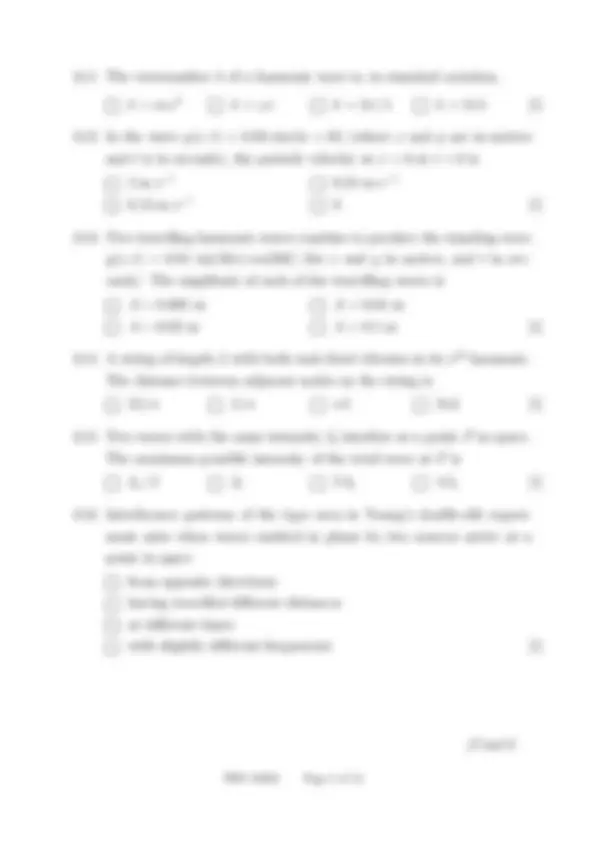
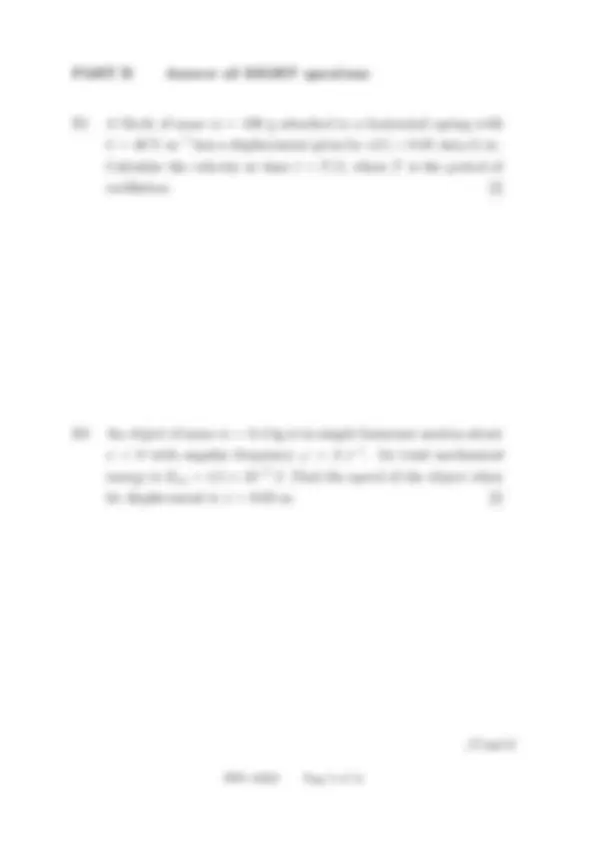
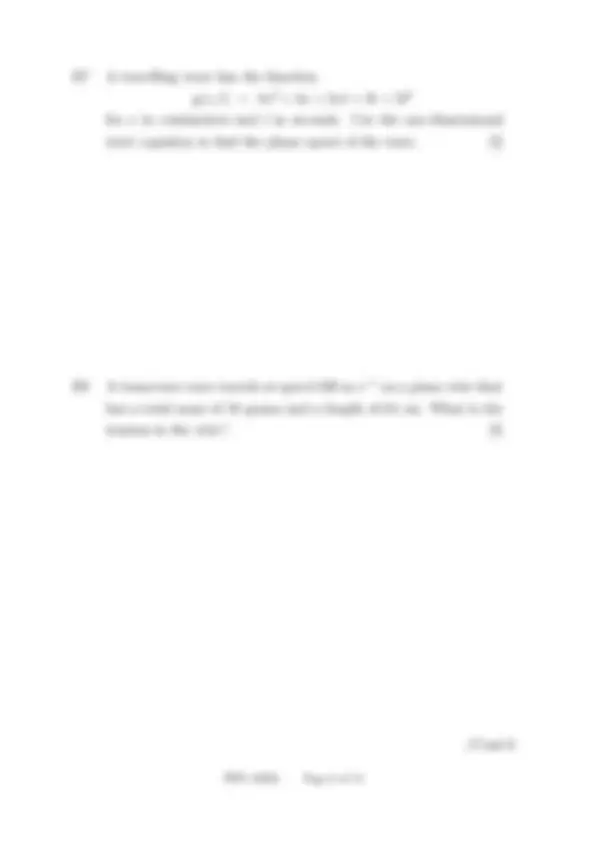
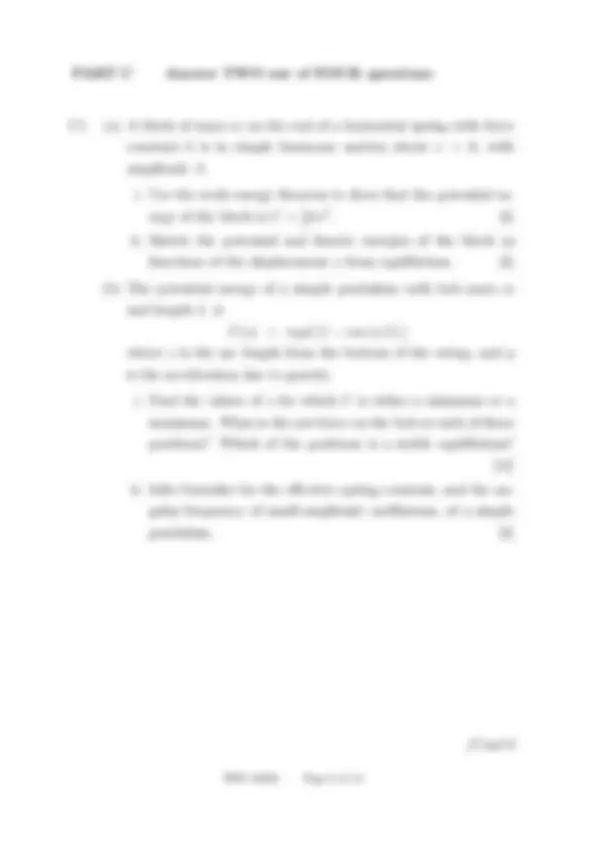
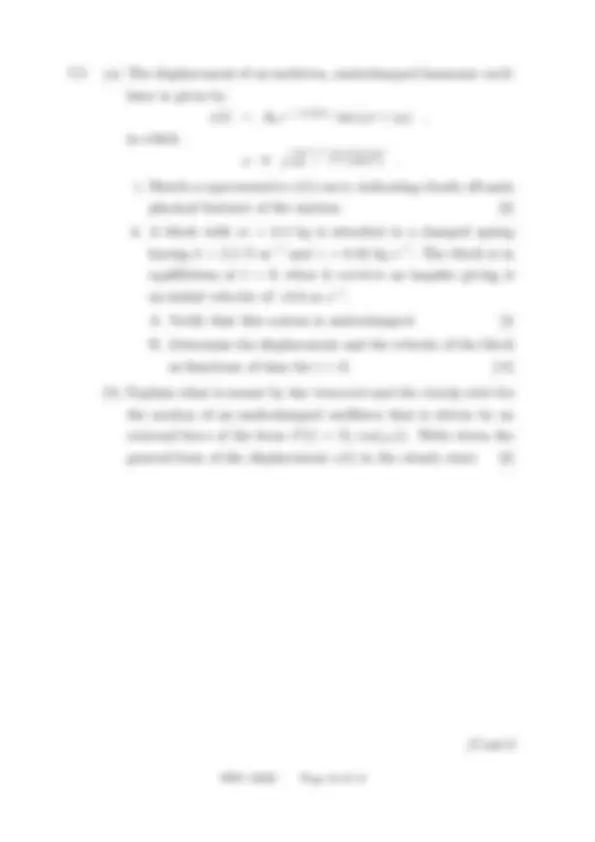


Study with the several resources on Docsity

Earn points by helping other students or get them with a premium plan


Prepare for your exams
Study with the several resources on Docsity

Earn points to download
Earn points by helping other students or get them with a premium plan
Community
Ask the community for help and clear up your study doubts
Discover the best universities in your country according to Docsity users
Free resources
Download our free guides on studying techniques, anxiety management strategies, and thesis advice from Docsity tutors
Prof Aneurin Evans, Keele University, Pyhsics and AstroPhysics, Exam 2011, Oscillations and Waves, oscillation, simple pendulum, simple harmonic motion, oscillator, natural angular frequency, Young’s double-slit experiment, damped harmonic, work-energy theorem, third harmonic.
Typology: Exams
Uploaded on 09/29/2011
1 / 12

This page cannot be seen from the preview
Don't miss anything!







Please write your 8-digit student number here:
Level I
Tuesday 24th^ May 2011, 09.30-11.
PHYSICS/ASTROPHYSICS
PHY-
OSCILLATIONS AND WAVES
Candidates should attempt ALL of PARTS A and B, and TWO questions from PART C. PARTS A and B should be answered on the exam paper; PART C should be answered in the exami- nation booklet which should be attached to the exam paper at the end of the exam with a treasury tag. PART A yields 16% of the marks, PART B yields 24%, PART C yields 60%.
Please do not write in the box below A C1 Total B C C C
NOT TO BE REMOVED FROM THE EXAMINATION HALL
PART A Tick one box by the answer you judge to be correct (marks are not deducted for incorrect answers)
A1 A block of mass m, hanging from a spring with force constant k and natural length L, oscillates purely in the vertical direction. The an- gular frequency of the oscillation is ω =
√ k/m ω =
√ g/L ω =
√ mg/k ω =
√ k/mg [1] where g is the acceleration due to gravity.
A2 A simple pendulum on the surface of the Earth has a period of 1 second. On the moon, where the acceleration due to gravity is 6 times lower, the period of the same pendulum would be (^6) √ seconds 16 seconds 6 seconds √^16 seconds [1]
A3 An object is in simple harmonic motion about an equilibrium position, with an angular frequency of 3 s−^1 and an amplitude of 0.4 m. The speed of the object at the equilibrium position is 3 .6 m s−^1 2 .4 m s−^1 1 .2 m s−^1 0 [1]
A4 A particle is in simple harmonic motion. At how many times dur- ing one oscillation cycle are the kinetic and potential energies of the particle equal to each other? eight times four times two times one time [1]
A5 An oscillator with mass 300 g and natural angular frequency 6.00 s−^1 is damped by a force Fdamp = −γ x˙. The critical damping constant is γ = 1.80 kg s−^1 γ = 2.55 kg s−^1 γ = 3.60 kg s−^1 γ = 10.8 kg s−^1 [1]
/Cont’d
A11 The wavenumber k of a harmonic wave is, in standard notation,
k = mω^2 k = ωv k = 2π/λ k = 2πλ [1]
A12 In the wave y(x, t) = 0.03 sin(4x + 8t) (where x and y are in metres and t is in seconds), the particle velocity at x = 0 at t = 0 is 2 m s−^1 0 .24 m s−^1 0 .12 m s−^1 0 [1]
A13 Two travelling harmonic waves combine to produce the standing wave y(x, t) = 0.01 sin(40x) cos(60t) (for x and y in metres, and t in sec- onds). The amplitude of each of the travelling waves is A = 0.005 m A = 0.01 m A = 0.02 m A = 0.1 m [1]
A14 A string of length L with both ends fixed vibrates in its nth^ harmonic. The distance between adjacent nodes on the string is 2 L/n L/n nL 2 nL [1]
A15 Two waves with the same intensity I 0 interfere at a point P in space. The maximum possible intensity of the total wave at P is I 0 / 2 I 0 2 I 0 4 I 0 [1]
A16 Interference patterns of the type seen in Young’s double-slit experi- ment arise when waves emitted in phase by two sources arrive at a point in space from opposite directions having travelled different distances at different times with slightly different frequencies [1]
/Cont’d
PART B Answer all EIGHT questions
B1 A block of mass m = 100 g attached to a horizontal spring with k = 40 N m−^1 has a displacement given by x(t) = 0.05 sin(ωt) m. Calculate the velocity at time t = T /2, where T is the period of oscillation. [3]
B2 An object of mass m = 0.4 kg is in simple harmonic motion about x = 0 with angular frequency ω = 3 s−^1. Its total mechanical energy is Etot = 4. 5 × 10 −^3 J. Find the speed of the object when its displacement is x = 0.03 m. [3]
/Cont’d
B5 Give a sketch illustrating the two normal modes of oscillation for a coupled pair of identical blocks on identical springs. [3]
B6 A long string carries a transverse harmonic wave travelling in the negative-x direction with amplitude 2 cm, wavelength 60 cm, and frequency 440 Hz. The displacement of the string at x = 0 at t = 0 is y = 0. Write the wave function, y(x, t). [3]
/Cont’d
B7 A travelling wave has the function y(x, t) = 8 x^2 + 6x + 8xt + 3t + 2t^2 for x in centimetres and t in seconds. Use the one-dimensional wave equation to find the phase speed of the wave. [3]
B8 A transverse wave travels at speed 330 m s−^1 on a piano wire that has a total mass of 10 grams and a length of 64 cm. What is the tension in the wire? [3]
/Cont’d
C2 (a) The displacement of an undriven, underdamped harmonic oscil- lator is given by x(t) = A 0 e−γ t/(2m)^ sin (ωt + φ 0 ) , in which ω ≡
√ ω^20 − γ^2 /(4m^2 ). i. Sketch a representative x(t) curve, indicating clearly all main physical features of the motion. [6] ii. A block with m = 0.4 kg is attached to a damped spring having k = 2.5 N m−^1 and γ = 0.56 kg s−^1. The block is in equilibrium at t = 0, when it receives an impulse giving it an initial velocity of +0.6 m s−^1. A. Verify that this system is underdamped. [4] B. Determine the displacement and the velocity of the block as functions of time for t > 0. [14] (b) Explain what is meant by the transient and the steady state for the motion of an underdamped oscillator that is driven by an external force of the form F (t) = F 0 cos(ωet). Write down the general form of the displacement x(t) in the steady state. [6]
/Cont’d
C3 (a) Give an argument as to why a wave travelling with speed v in one dimension must depend on position x and time t only in one of the combinations (x − vt) or (x + vt). [6] (b) The function y(x, t) = A sin [k(x − vt) + φ 0 ] describes a travelling harmonic wave. For such a wave: i. The wavelength λ is defined as the smallest length such that y(x + λ, t 0 ) = y(x, t 0 ) for any x at a fixed t 0. Use this to derive the standard relation between k and λ. [6] ii. Show that y undergoes simple harmonic oscillation at any fixed position x in the wave. Thus, express the angular frequency ω of the wave in terms of k and v. [6] (c) Consider the function y(x, t) = 4 ex−^2 t^ − e^3 x−^6 t^. i. Verify that this function is a solution to the one-dimensional wave equation. [6] ii. Show that ∂^2 y/∂t^2 + 8 ∂y/∂t + 12 y = 0. Thus, what kind of oscillation drives this wave? [6]
/Cont’d